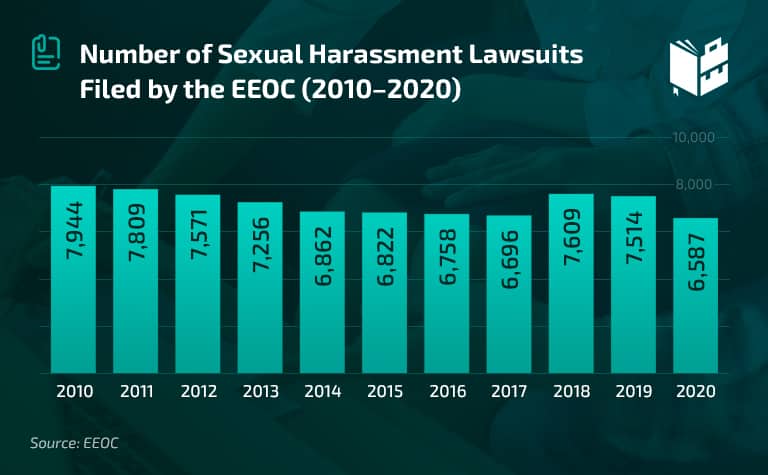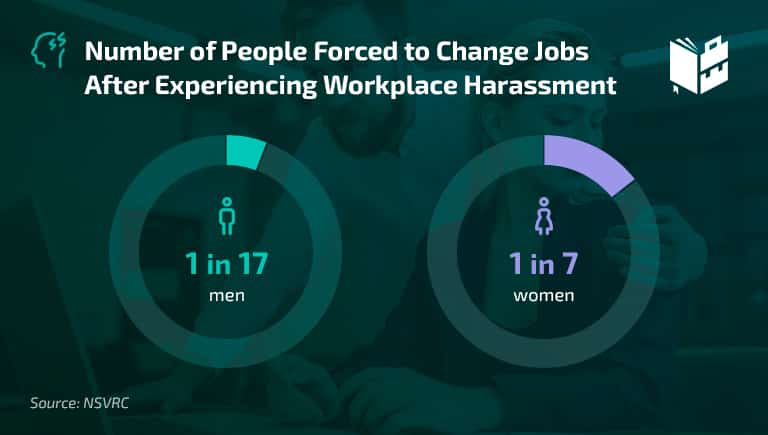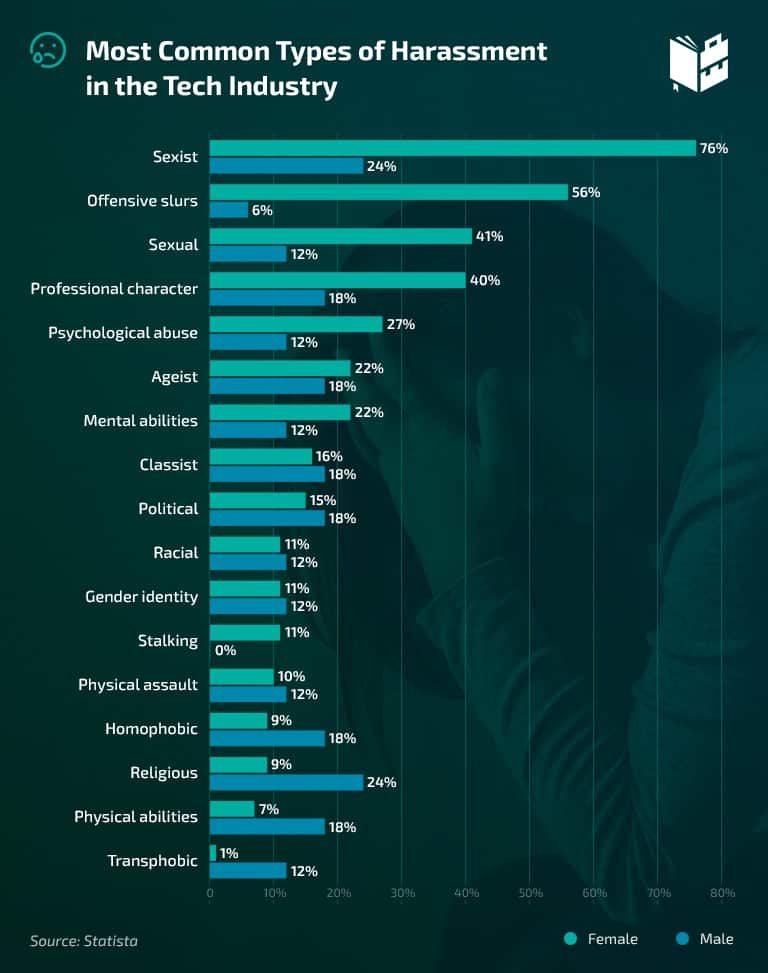Preventing sexual harassment is a top priority, and more and more companies are looking to provide mandatory training to each employee. Sexual harassment in the workplace statistics indicate that such training provides adequate and practical information so that every individual is fully aware of such behavior and its consequences.
The definition of sexual harassment is unwelcome behavior in the form of sexual advances, requests for sexual favors, or inappropriate sexual remarks.
There are two types of sexual harassment — quid pro quo and a hostile working environment. The former is defined as an exchange of sexual services, while the latter is any harassment in the workplace that can create an intimidating environment for the victim.
Let’s delve into the numbers and see how widespread these incidents are.
Statistics on Sexual Harassment in the Workplace (Editor’s Choice)
- 44% of women in the restaurant industry have experienced sexual harassment from someone in a management or ownership role.
- Only 17% of sexually harassed male nurses report it to their employer.
- Roughly 58% of women harassed at work don’t file a complaint.
- Only 1% of sexually harassed victims confront their perpetrators.
- Seven out of 10 disabled women have experienced sexual harassment in the workplace.
- 141 countries have laws on sexual harassment in the workplace.
- $22,500 per person is the average cost of lost productivity.
- 31% of all victims feel depressed and anxious upon experiencing sexual harassment or assault.
Workplace Harassment Statistics for 2022
1. 71% of female restaurant workers have been sexually harassed at least once during their time in the restaurant industry.
(One Fair Wage)
According to a recent SRSS survey, the number of sexually harassed women in the restaurant industry is the highest among those reporting sexual harassment. In addition, current sexual harassment workplace statistics show that customers harass women in this industry most frequently.
2. 44% of women in the restaurant industry have experienced sexual harassment from someone in a management or ownership role.
(One Fair Wage)
The same report confirms the degree of mistreatment female restaurant employees are exposed to at work. Apparently, supervisors, managers, and restaurant owners pervasively sexualize female restaurant employees. Unfortunately, 98% of the harassed respondents faced at least one incident of retaliation from a person in charge.
3. 76% of tipped workers who receive a subminimum wage experience sexual harassment.
(One Fair Wage)
Statistics of sexual harassment in the workplace reveal that tipped workers in the states with a subminimum wage of $2.13 report double the rate of sexual harassment compared to tipped workers with no subminimum wage.
Nowadays, the situation is relatively the same — three-quarters of tipped workers have been sexually harassed. In comparison, 52% of non-tipped workers have been treated the same way.
4. Only 17% of sexually harassed male nurses report it to their employer.
(Nursing Times)
Overall, female nurses are more frequent subjects of sexual harassment. But sexual harassment statistics by gender tell us that men aren’t spared either. The fact that 51% of the male respondents in this particular survey said they had been sexually harassed is more than worrying.
Additionally, it’s devastating that such behavior is seen as a joke when it involves male victims.
5. The most common form of sexual harassment among nurses is verbal (56%).
(Nursing Times)
The image of a nurse and her uniform is highly sexualized in the media. Consequently, nurses are exposed to various forms of sexual harassment. In addition, more than half of them face suggestive verbal comments from men.
Sexual harassment in the workplace stats also detect other common forms of harassment female nurses face — physical (37%), visual (29%), and cyber (6%). The numbers include both experienced nurses and students.
6. Medical colleagues perform acts of sexual harassment in 26% of cases.
(Nursing Times)
Contrary to the general belief, other medical staff members aren’t the most common perpetrators; patients are in 58% of cases. In this survey, the victims of sexual harassment say that incidents are tolerated and often ignored when involving patients as perpetrators.
Sexual Harassment in the Workplace Statistics
Harassment isn’t necessarily physical. Verbal harassment or sexual remarks can also be offensive, especially for women. It is unlawful to harass a person in any situation, especially if that person is a co-worker or another employee.
7. 38% of women experience sexual harassment at the workplace.
(NPR)
In general, 77% of women are verbally harassed, while 51% are touched without permission. Such behavior is pervasive as it shows that more than half of the women in the workplace experience these issues. These female harassment in the workplace statistics are enough for every company to address them adequately and establish a positive environment without any fear of misconduct.
8. Roughly 58% of women harassed at work don’t file a complaint.
(HBR)
The number one reason is the fear of retaliation. Another reason is the uncertainty regarding the definition of harassment. To add to that, many women state people do not believe them when they report such incidents.
Nearly a quarter of surveyed individuals said they had been harassed. However, sexual harassment statistics claim that, when it was explained to them that specific acts, offensive remarks, or crude jokes could also be considered harassment, the number of respondents claiming that they had experienced harassment doubled.
9. EEOC filed a total of 5,581 lawsuits, a slight decrease compared to the year before (6,587).
(EEOC)
The same report shows that men filed 16.3% of the total number of lawsuits. Male sexual harassment in the workplace statistics reveal that the percentage has been more or less the same for the last 10 years. Nevertheless, the movement helped many men and women to come forward with the intent to free the workplace from any kind of harassment.

10. 81% of women have experienced some form of sexual harassment in their lifetime.
(Stop Street Harassment)
This report also reveals that 43% of men have experienced some form of sexual harassment in their lifetime. That is a fairly large percentage considering other data collected on this topic. That could be due to the anonymity factor. Sexual harassment reporting statistics show that not many men and women are strong or confident enough to speak out publicly.
11. Only 1% of sexually harassed victims confront their perpetrators.
(NPR)
This stat shows exactly how challenging it is to confront the person who made the victim suffer. After all, it’s not easy to face the abuser, especially if sexual harassment was the case. As the previous stat shows, it’s much easier for victims to change their lives or file an official report than confront harassers directly.
12. 99% of employees successfully recognize a sexual harassment situation.
(True Office Learning)
Sexual harassment at work statistics reveal that employees are taking steps toward eliminating potentially dangerous scenarios. Recent workplace violence statistics have taught us that people are not afraid to address this issue. It is reported that almost all individuals show support and want to fight against sexual misconduct.
13. 34% of employees do not identify behavior that leads to a hostile working environment.
(True Office Learning)
While almost every employee is aware of the consequences of sexual misconduct, not everyone truly grasps the concept of harassment. Surprisingly, workplace sexual harassment statistics tell us that a third of employees do not understand the elements of sexual harassment, which can potentially create a hostile working environment.
14. Seven in 10 disabled women have experienced sexual harassment in the workplace.
(TUC)
In other words, 68% of disabled women have experienced some form of sexual harassment at work. It’s a pretty high percentage, especially when compared to 52% of women sexually harassed at work in general.
With a 49% rate, unwelcome sexual jokes are the most common form of workplace-related sexual harassment disabled women face.
Facts and Stats on Sexual Harassment in the Workplace
In the last few years, sexual harassment awareness has brought this problem to light. With the latest publicly disclosed sexual harassment issues in the workplace, it’s essential to understand the facts to act properly.
15. 15% of companies have made an effort to create specific strategies to address sexual harassment issues.
(HRAcuity)
Since the start of the #MeToo movement, companies have begun addressing this issue more. If the latest reports are true, two out of 10 companies attempt to eliminate all current and potential future inappropriate behavior in the workplace.
16. LGBT sexual harassment in the workplace statistics say 68% of LGBT workers have experienced sexual harassment at work.
(TUC)
The most recent available data imply that almost seven out of 10 LGBT workers are victims of sexual harassment at work. Unsurprisingly, two-thirds of these incidents go unreported because LGBT workers fear they will get fired.
17. One in seven women and approximately one in 17 men have sought different job opportunities due to harassment in the workplace.
(NSVRC)
Workplace harassment is very common, but it is rarely reported. More than 85% of the victims do not file a complaint or press charges based on harassment in the workplace statistics. More worrying is that most victims do not even talk about it with their co-workers or superiors. Instead, they opt to quit their jobs or work for a different company.

18. 23% of women working from home due to the pandemic report an increase in sexual harassment incidents.
(Rights of Women)
An online survey on women’s experiences of sexual harassment at work shows that female employees continued facing inappropriate behavior while working from home. Everyone switched to online communication due to the pandemic, which led to the harassment moving online.
Sexual harassment in the workplace statistics suggest that, as a result, 45% of women experienced harassment remotely. For example, they received sexual messages (email, texts, social media), sexual calls, and cyber harassment (Zoom, Teams, Slack, and similar).
19. 141 countries have laws on sexual harassment in the workplace.
(World Bank)
Over the last couple of years, women have successfully fought for equality and a better working environment. Unfortunately, women in the workplace statistics emphasize that women in many countries still don’t have legal protection against sexual harassment in the workplace. Hopefully, these countries will live up to the standards soon.
20. Sexual assault in the workplace statistics show that 7% of women and 4% of men have been sexually assaulted at work.
(Marker)
Research shows that, when a man suffers a sexual assault in the workplace, a woman is a perpetrator in 76% of the cases. Similarly, the majority of women are assaulted by men (94%).
21. 41% of female founders in the tech industry worldwide experience sexual harassment in the workplace.
(Statista)
Overall, a larger share of women tech founders experience sexual harassment in the workplace than men founders (12%). Moreover, 11% of women report stalking, while men haven’t experienced it at all. These and similar issues women in tech encounter are regularly discussed at annually-held global women in tech conferences.

Statistics About Sexual Harassment in the Workplace — Cost and Effects
The #MeToo movement raised awareness against sexual harassment in the workplace, and it took a huge toll on people’s personal lives. Sexual harassment in the workplace is widespread, and women suffer the most. Studies estimate that 25%–85% of them experience some sort of harassment at work. Although women are usually victims, a significant percentage of men are also victims of sexual harassment.
Workplace harassment statistics show numerous solutions to this problem, such as anti-harassment policy, training implementation, discouraging misconduct, limiting the number of alcoholic beverages at office parties, and similar.
Workplace harassment can affect an individual in many ways and cost companies a lot of money at the same time.
22. Employees alleging sexual harassment in the workplace gained $137 million.
(Pasternak Law)
Amounts of financial payouts by companies are usually kept confidential, but EEOC is responsible for publishing financial settlements on behalf of all victims. The latest available statistics on sexual harassment in the workplace don’t include charges filed with state and local Fair Employment Practices Agencies, so the number could be higher or lower.
23. The lifetime costs of sexual harassment and retaliation for an apprentice in the construction trades reach $1.3 million.
(Time’s Up Foundation)
Workplace sexual harassment imposes financial costs on affected individuals. These costs can affect workers immediately or over time. For example, being fired or forced to leave a job, cutbacks in shifts, demotions, and lost promotions result in lifetime costs that vary across industries.
Sexual harassment facts regarding the cost of workplace sexual harassment show that it is exceptionally high for those working in well-paid male-dominated occupations.
24. Forced career change due to sexual harassment can translate to $125,600 for workers in low-wage service jobs.
(Time’s Up Foundation)
A forced job change is one of the retaliation forms sexually harassed employees face. It causes delayed career advancement, besides the loss of earnings. Moreover, wage gap statistics show that workplace sexual harassment reinforces the gender pay gap.
Statistics for sexual harassment in the workplace suggest that several women from the study used to have well-paying career paths in male-dominated occupations. But they were pushed out to low-paying, often women-dominated industries due to sexual harassment at work.
25. $22,500 per person is the average cost of lost productivity because of workplace sexual harassment.
(Deloitte)
Judging by this data, the negative effects of harassment are also detrimental to the company since all employees are heavily affected by such scenarios. Sexual harassment can reduce the motivation and productivity of an employee. This, in turn, can influence overall job satisfaction.
26. 31% of victims feel depressed and anxious upon experiencing sexual harassment or assault.
(NPR)
These are staggering numbers that provide insight into what victims deal with. Facts about sexual harassment in the workplace show that most victims make life-changing decisions, such as changing their jobs, ending relationships, or even marriages.
Sexually abused victims often opt to change schools, quit their jobs, move out of their house, or simply stop interacting with their community members. Numerous reports have confirmed the victims act this way, even after seeking help.
Sexual Harassment Statistics — The Bottom Line
Harassment is unwelcome behavior directed toward an individual based on age, gender, race, sexual orientation, and similar. A stable working environment must be provided by every company, together with sexual harassment training.
Not only that, but companies need to take these matters seriously, as abuse in the workplace can have a series of consequences that can last a lifetime. If you want to find out more about this problem, these stats provide significant insight into what men and women are dealing with daily.